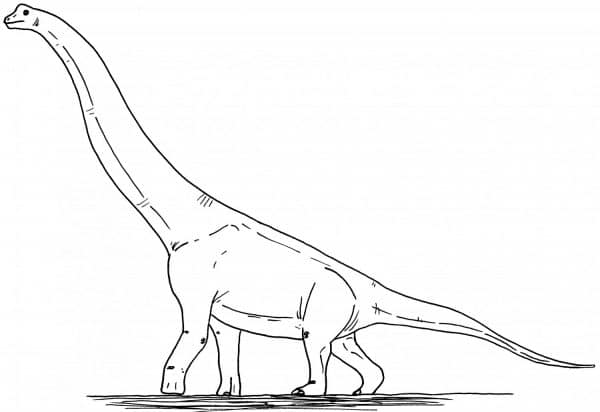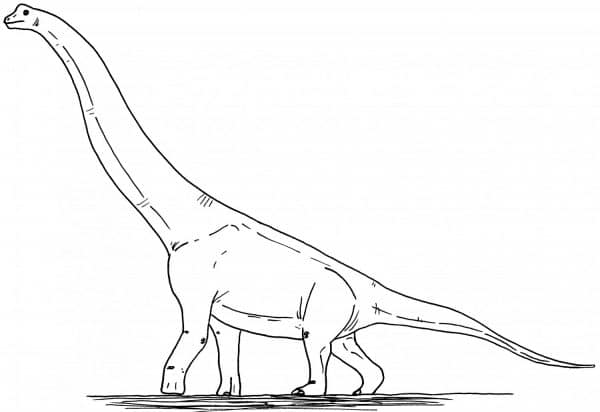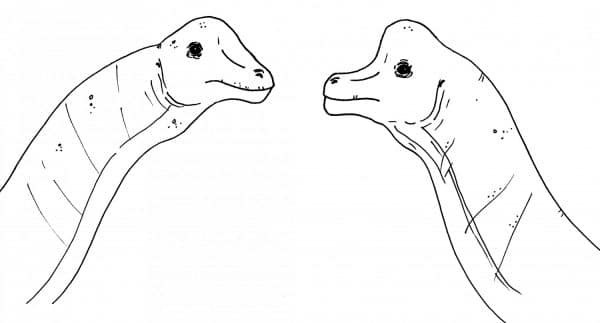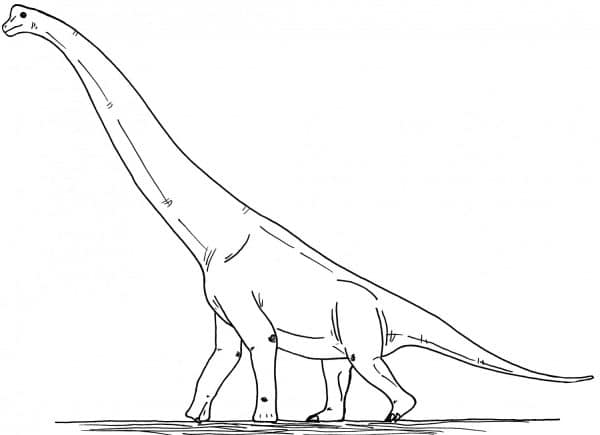
Brachiosaurus. The towering, graceful, giraffe-like sauropod with its skyward-stretching neck grazing the heavens, representing the peak of dinosaurian spectacle in the Jurassic. While the elongate Diplodocus and chunky Brontosaurus probably make it into dinosaur books to represent sauropods more often, and it hasn’t been considered the biggest dinosaur for several decades now, Brachiosaurus still stands as shining testament to the grandeur of evolution in the hearts of dinosaur fans worldwide. However, the animal you’re likely picturing in your head right now is not Brachiosaurus.
How can this be? Is this one of those Apatosaurus/Brontosaurus or Triceratops/Torosaurus things? Why can’t paleontologists leave our most beloved dinosaurs alone? Well fear not, because Brachiosaurus is still a valid dinosaur, and there’s a good reason as to why the animal you think is Brachiosaurus actually isn’t.
Brachiosaurus was named in 1903 by Elmer Riggs of Chicago’s Field Museum (Riggs, 1903). It was discovered in Colorado, from late Jurassic Rocks that had already yielded famous sauropods like Camarasaurus, Apatosaurus, Brontosaurus, and Barosaurus during the 19th century’s Bone Wars. Riggs’ material consisted of an incomplete skeleton from some kind of giant sauropod, the biggest one known at the time. Though it had no skull, Riggs could tell that this dinosaur was unlike anything discovered before. Aside from the colossal size of the bones, this new dinosaur’s humerus or upper arm bone was about as long as its femur, or thigh bone. Because of this, the dinosaur had an upright, giraffe-like stance (I don’t know for sure if it could rear up on its hind legs, but for an animal that was extremely tall with front limbs were longer than its back limbs, it seems unnecessary). This was in contrast to all other known sauropods at the time, which had arms much shorter than their legs. Riggs named his new dinosaur Brachiosaurus altithorax, meaning ‘arm reptile’ and ‘deep chest’, for this trait.

The American Brachiosaurus altithorax. Though the holotype was pretty fragmentary, more fossils have filled in the gaps of this species. By Nicholas Carter, based off Scott Hartman’s skeletal
Despite its impressive size, the fragmentary nature of Brachiosaurus meant that it did not immediately join its compatriots as a mounted skeleton in a museum hall, and so eluded public fame for some time. But then, out of what is now Tanzania, came another giant sauropod from the late Jurassic rocks of the Tendaguru Formation. After being recovered in one of the biggest fossil excavations of all time, the dinosaur was described by German paleontologist Werner Janensch in 1914. Janensch saw many similarities between his new African dinosaur and the North American Brachiosaurus, and so he described it as a second species of that genus: Brachiosaurus brancai (Janensch, 1914).
This African specimen, which included a good chunk of the skeleton and skull, was significantly more complete than the American species. It was mounted in an impressive display at the Natural History Museum in Berlin, and until the discoveries of the great titanosaurs in the 1990’s, it was considered the largest dinosaur in the world. Brachiosaurus brancai quickly became the gold standard for depictions of Brachiosaurus in books, television, and movies, with the American species generally assumed to be basically the same thing. Picture a Brachiosaurus in your mind now, and chances are you’re imagining the African Brachiosaurus brancai.
However, some voices of dissent arose in the 1980’s regarding the similarity of Brachiosaurus altithorax and B. brancai. After taking a hard look at the specimens of each species, freelance paleontologist Greg Paul argued that the well-known B. brancai was actually less similar to B. altithorax in the shape and proportions of its bones than most people realized. He suggested, therefore, placing it within a subgenus he called Giraffatitan based on the giraffe-like build of the animal (Paul, 1988). Although this slight reclassification didn’t catch on with most scientists right away, the differences between the American and African specimens began to slowly pile up.
In 1998, a description of an incomplete sauropod skull from late Jurassic Colorado rocks was published. This skull had been hanging around for a while, having once been a part of Othniel Charles Marsh’s collection before being transferred to the Smithsonian following the paleontology tycoon’s passing. Marsh had used this fragmentary cranium as a basis for reconstructing the skull of his Brontosaurus (Marsh, 1896). The 1998 study, however, argued that this was not a Brontosaurus skull (which by then was reasoned to have had a head similar to that of Diplodocus), but was actually the skull of an American Brachiosaurus species (Carpenter & Tidwell, 1998). Though incomplete, the authors were able to reconstruct the missing parts to get a decent sense of what the full skull looked like, but couldn’t determine whether the skull belonged to Brachiosaurus altithorax specifically or some other undescribed species of American brachiosaur, since no other bones were associated with it. That said, it certainly could have come from B. altithorax. Though somewhat similar overall to the skull of the Tanzanian brachiosaur with the large, high-set nasal openings creating that distinctive helmet-shape, the American skull had a more elongate snout with a less dramatic ‘swoop’ as the nasal region rises up over the eyes.

The American Brachiosaurus (left) and African Giraffatitan (right) heads for comparison. Soft tissue may have filled in much more of that swoop between the snout and the nasal bones. By Nicholas Carter
Then, in 2009, paleontologist Michael Taylor published a detailed description of known material from both the American and Tanzanian brachiosaurs. This study determined that, though the two dinosaurs were closely related, there were enough differences to justify separating them into two distinct genera (Taylor, 2009). While the American Brachiosaurus altithorax got to stay as it always was thanks to the rules of naming priority, the Tanzanian brachiosaur needed a different name. Since Paul had suggested the genus name Giraffatitan for the African species back in ‘88, the rules said Taylor had to go with that name (though he appears to have not been a fan of the name, based on his comments in the paper). And so, the Brachiosaurus that everyone knew and loved the most, the one all your beloved depictions in the media are based on, is actually called Giraffatitan brancai.
So what are the differences between these two dinosaurs? How can you tell if you’re looking at a Brachiosaurus or Giraffatitan next time an unidentified brachiosaur crosses your path? The differences between the two laid out in Taylor, 2009 are subtle, yet many. But we won’t get into the anatomical minutiae that differentiate the two here, and instead we’ll look at the broad strokes.
Brachiosaurus and Giraffatitan lived at nearly the same time, both dating back to near the end of the Jurassic Period. While they lived in what are now very different places (the American plains versus the African savannah), in those days the continents were much closer together, and the fauna of the Morrison Formation where Brachiosaurus comes from and the Tendaguru Formation which yields Giraffatitan had some interesting overlap. Aside from each having at least one distinctive brachiosaur, both ecosystems also had long, mid-browsing dipolodocid sauropods, small herbivorous dryosaurs, armored stegosaurs, and a variety of predatory carnosaurs.

The African Giraffatitan brancai. Note the shorter torso and tail, and somewhat slimmer build. By Nicholas Carter, based of Scott Hartman’s skeletal
As far as the dinosaurs themselves go, we’ve already touched on the skulls, but there’s some general differences behind the head that separates the two brachiosaurs. Brachiosaurus appears to have had a sturdier build than Giraffatitan, with its bulkier front limbs placed a little wider. It also had a longer tail and torso for its size. Giraffatitan was a noticeably more slender and compact dinosaur, giving it that recognizable giraffe-like body shape. For a while the two were considered each other’s closest relatives, but the discovery and study of more species in the brachiosaur family has shown that they probably aren’t sister taxa (Mannion et al., 2017). Brachiosaurus and Giraffatitan were about as closely related as the modern cougar and cheetah are to each other. It wouldn’t be surprising, therefore, if they turned out to look pretty different from each other in life. We don’t know what colour these dinosaurs were, or exactly what soft-tissue features they had that aren’t hinted at in the skeleton, but it’s not outlandish to suggest that Brachiosaurus and Giraffatitan wouldn’t have been too hard to tell apart if you could go back and see them alive side-by-side.
All of that said, does a change in name make our beloved ‘Brachiosaurus’ any different? People hold dearly to the things they learned about as children, and scoff at science when names and labels change (Pluto, anyone?). But do remember that no matter what their names, Brachiosaurus and Giraffatitan were both real, wonderful animals that existed here without a care as to what a bunch of semi-bald primates would go on to call them. A Brachiosaurus by any other name is still as sweet.
By Nicholas Carter
References
Carpenter, K.; Tidwell, V. (1998). “Preliminary description of a Brachiosaurus skull from Felch Quarry 1, Garden Park, Colorado”. Modern Geology. 23(1–4): 69–84.
Janensch, W (1914). “Übersicht über der Wirbeltierfauna der Tendaguru-Schichten nebst einer kurzen Charakterisierung der neu aufgeführten Arten von Sauropoden”. Archiv für Biontologie. 3 (1): 81–110.
Philip D. Mannion; Ronan Allain; Olivier Moine (2017). “The earliest known titanosauriform sauropod dinosaur and the evolution of Brachiosauridae”. PeerJ. 5: e3217.
Marsh, 0. (1896) The dinosaurs of North America. U.S. Geo!. Surv. Ann. Rep., 16, 133-244.
Paul, G. S. 1988. The brachiosaur giants of the Morrison and Tendaguru with a description of a new subgenus, Giraffatitan, and a comparison of the world’s largest dinosaurs. Hunteria 2:1–14.
Taylor, M.P. (2009). “A Re-evaluation of Brachiosaurus altithorax Riggs 1903 (Dinosauria, Sauropod) and its generic separation from Giraffatitan brancai (Janensch 1914)” (PDF). Journal of Vertebrate Paleontology. 29 (3): 787–806
Riggs, E.S. (1903). “Brachiosaurus altithorax, the largest known dinosaur”. American Journal of Science. 4. 15 (88): 299–306.

